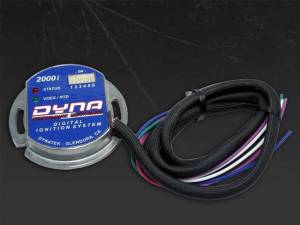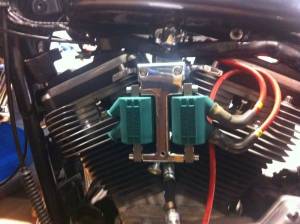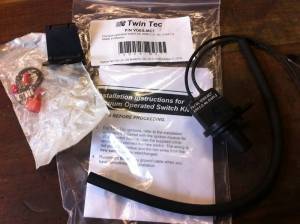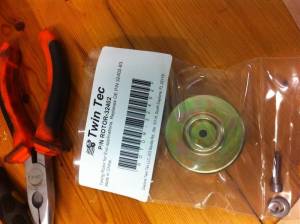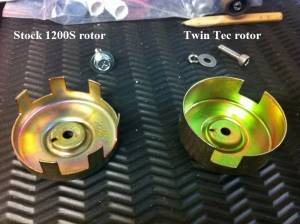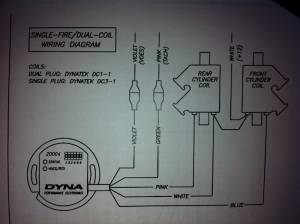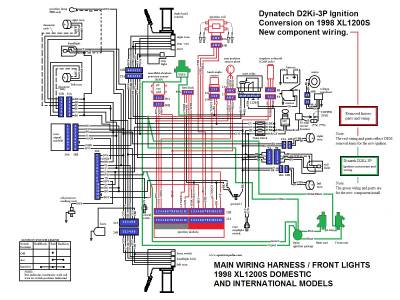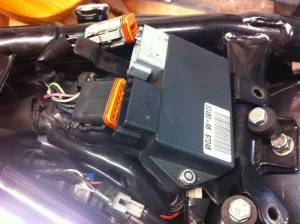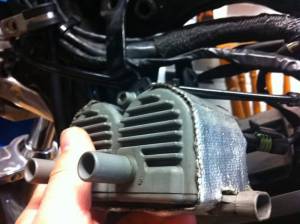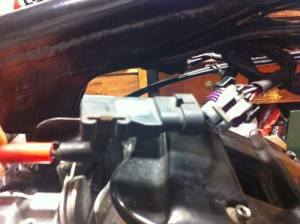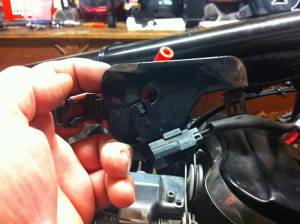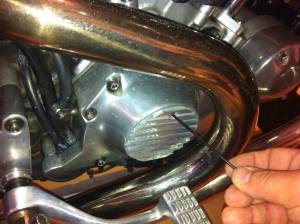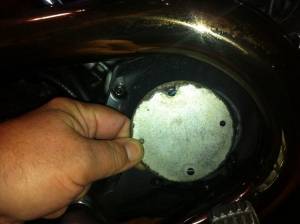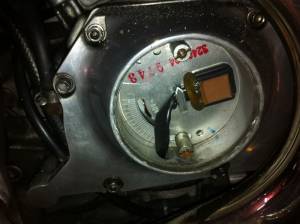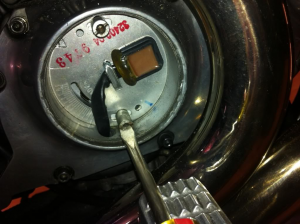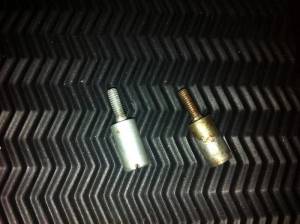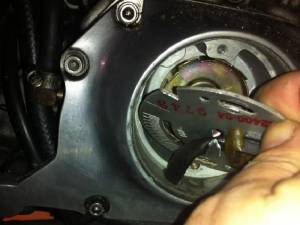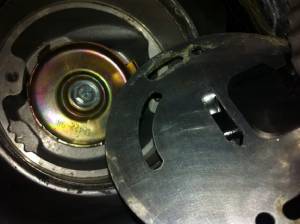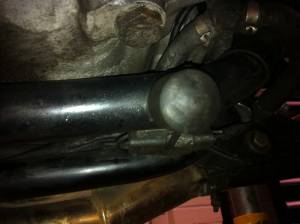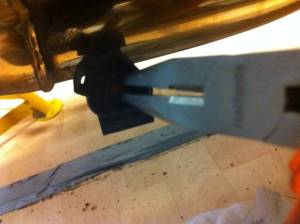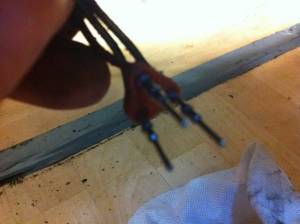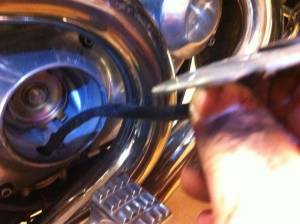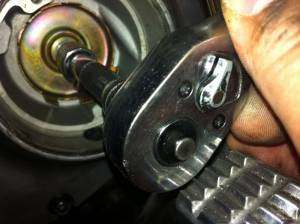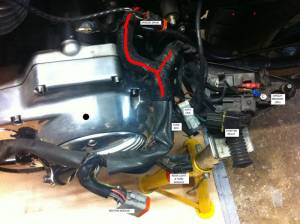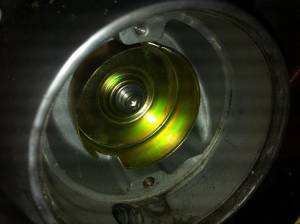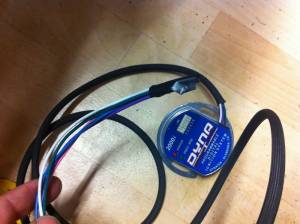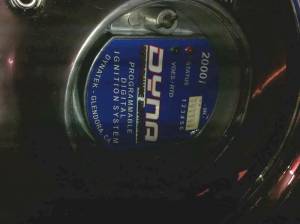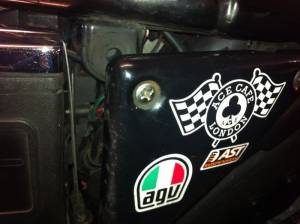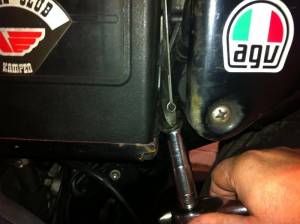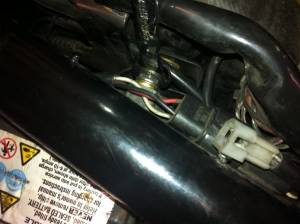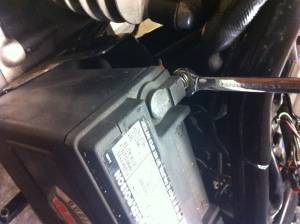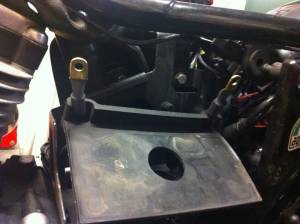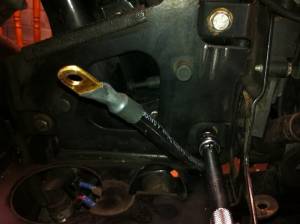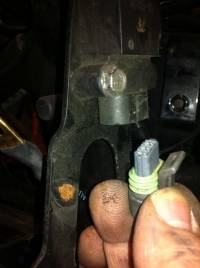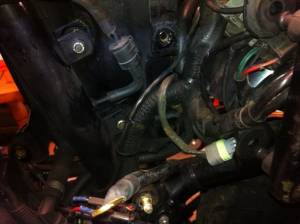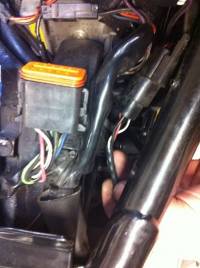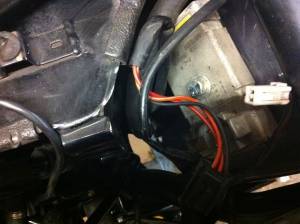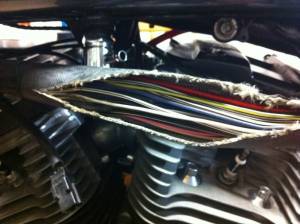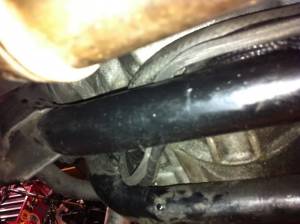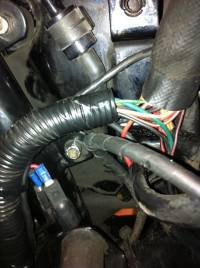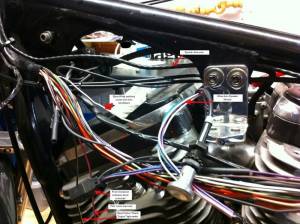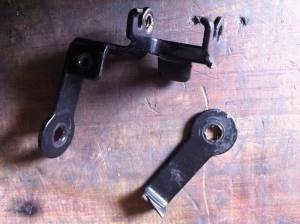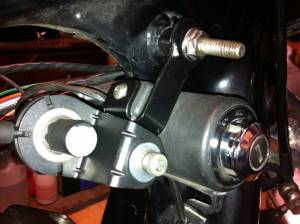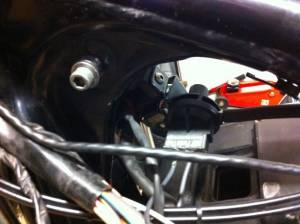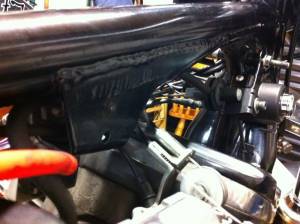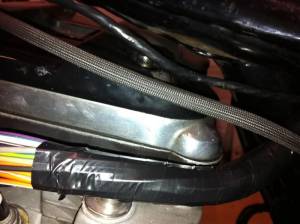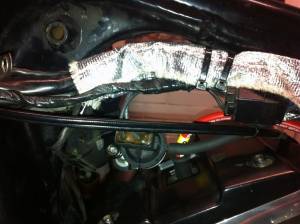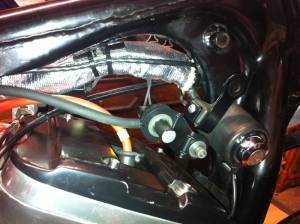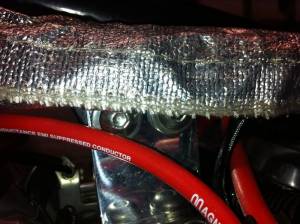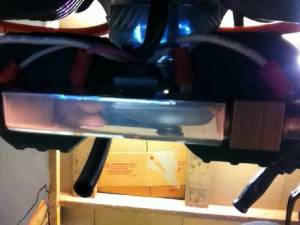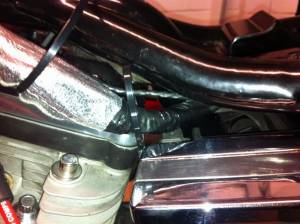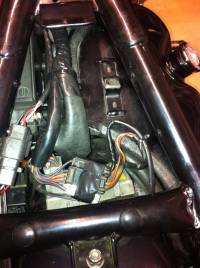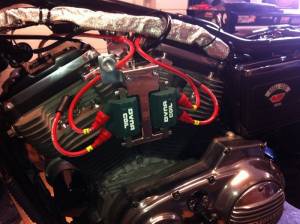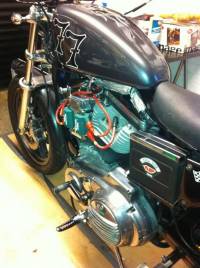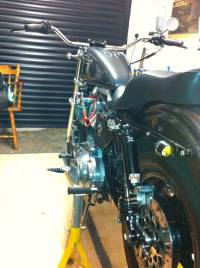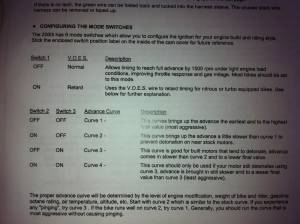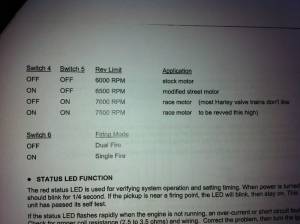Table of Contents
This is an old revision of the document!
REF: Engine Control - Sub-01a
'98-'03 Sportster Sport 1200S Dynatek D2Ki-3P Ignition Conversion
Article by steelworker of the XLFORUM 1)
Changing to an after market ignition system is something that will probably come to all 1200S owners eventually as stock and SE ignition components become more difficult to source. 2) PLEASE NOTE: by doing this mod, you will lose certain functions from the 1200S. Specifically, the diagnostic (fault code) function and the related check-engine light on the speedo, which are both tied into the stock ignition module. The frame-mount Sportster electrical system is so basic (and this modification will make it even more simple), that a diagnostic sytem with data-link can be considered more or less redundant.
Swapping the ignition module means you also have to swap the coils, as most aftermarket systems require coils with a 3 ohm primary resistance, compared to 0.5 ohm for the stock 1200S coils.
Parts
The ignition used below is the Dynatek D2Ki-3P, which comes with two traditional style Dyna DC1-1 twin-post coils.
The Dynatek module has switches on the front to pick different advance curves.
For about another $120 you can get a programming kit with harness (when you plug in the programmer, you can upload a map and disable the switches on the module).
But one of Dynatek's (very helpful) reps advised to try the switches first - he said that among the range available there should be a curve to suit most bikes.
Note from Daytona Twin Tec's website:
The Sportster 1200S model with dual plug heads comes with a special ignition module, similar to that used on Twin-Cam 88® models. If you require a programmable aftermarket ignition for the 1200S, you can use the Model 1005 EX version (not the 1005S). The Model 1005 mounts in the nose cone. The original equipment coil has low resistance primary windings that are not compatible with the Model 1005. You must replace the original equipment coil with an aftermarket four tower coil, such as the Dyna DC6-4, that has 3 ohm primary resistance. Please refer to our Dual Spark Plug Tech Note for more details. You will have to remove the original equipment MAP sensor. You will also require our timing rotor (P/N ROTOR-32402) and VOES switch (P/N VOES-KIT-MC7).
A Daytona Twin Tec VOES kit was used to replace the MAP sensor. This is set at 6-7 in-Hg, instead of the stock 3.5-4.5 In-Hg, to reduce spark knock during light load and throttle roll-on. The kit comes with mounting bracket, electrical connectors, instructions and a new hose then coupled with their timing rotor, which is basically the stock rotor for most Harleys except the 1200S. See rotor comparison on right pic below.
Wiring Diagrams
Removing the stock ignition and parts
With the tank and seat removed, it's time to start stripping a few parts that won't be needed any more.
First, the stock ignition module and its mounting bracket. Remove the bolts from the two well nuts in the frame cross rail. Both of these will go, along with the two large Deutsch connectors.
Then remove the stock coil, it's mounting bracket and the MAP sensor.
The mounting bracket for the MAP sensor is glued to the frame.
It also serves as a mount for a “spare” electrical connector for the air filter trapdoor solenoid on bikes registered in California.
Remove the ignition cover to get to the stock ignition pick-up and timing rotor (if you have a stock cover, you'll need to drill out the two pop rivets that hold it in place).
When replacing with rivets, ensure you use the sealed back pop rivets from HD, or it's possible the center of the rivets could come adrift and wreck your ignition unit and rotor.
If you drilled out the rivets on your stock cover, you'll find an inner cover behind it, held on by two countersunk screws.
Remove them along with the backing plate to reveal the ignition pick-up.
With a flat-head screwdriver, remove the two pillar bolts holding the pick-up in place and pry out the pickup to reveal the ignition rotor behind it.
Unclip and disconnect the three-pin Deutsch connector clipped to the rear of the bottom frame rail.
These are the leads to / from the pick-up. It's just below the sidestand bump stop.
With a pair of thin-nose pliers, remove the orange plastic lock piece from inside the connector.
With a small pointy object, hold back the plastic lock tab holding each crimped connector inside the block, whie you push the connector outwards. When all three crimped connectors are clear of the lock tabs, carefully pull them out of the back of the connector; then remove the rubber sealing bung.
Then remove the bolt holding the ignition rotor in place and remove the rotor. It will probably be quite stiff to pull out, but gently work it side-to-side to get it moving.
Stock wiring removal
Remove the nylon braid and insulating tape from the area shown in red.
Under the braid on the main branch that sits behind the oil tank is a corrugated plastic sheath.
Remove it and put it aside to reinstall later.
It's a good idea to thread the Dynatek loom through the same route as the stock loom to see how much wire you have to play with.
It also helps you know where you can splice them in.
Working from left to right, top to bottom, of the factory wiring diagram you'll see:
MAP SENSOR:
All three wires removed back to the gray connector of the Ignition Module.
The Red/White wire is spliced to another Red/White coming from the Cam Position Sensor, which is also removed.
DATA LINK:
Black earth wire removed back to the first splice in the loom (this was later spliced in the earth lead from the new VOES switch).
The other three wires are removed all the way back to the gray and black connectors of the Ignition Module.
COIL:
Yellow/Blue and Blue/Orange wires removed all the way back to the black connector of the Ignition Module.
The White/Black wire is cut at the first splice in the loom.
Trace the wire going forwards from this big splice.
It is the main switched power wire from the Engine Stop/Run Switch to the Coil, Trapdoor Solenoid and Ignition Module (black connector) and spurs off to the Data Link.
This will be used later to provide power to the new coils and to the Dynatek module.
BANK ANGLE SENSOR:
Light Green/Gray wire removed back to the black connector of the Ignition Module.
Black wire removed back to the first splice.
Grey wire removed back to the connector at the fuse block.
The wiring diagram shows an in-line splice to the gray power wire coming from the fuse block, but the splice is actually at the fuse block.
CAM POSITION SENSOR:
Red/White wire removed completely (see MAP SENSOR above).
Green/White wire removed back to the gray connector of the Ignition Module.
Black/White wire removed back to the gray connector of the Ignition Module (including the splice to the MAP SENSOR - see above).
TRAPDOOR SOLENOID:
Unless you live in California, this is the spare connector clipped to a plate on the right hand side of the top frame rail, above the carb.
Black wire removed back to the first splice.
White/Black wire removed back to the first splice (this is the big splice mentioned under COIL above).
Green wire removed back to the first splice.
IGNITION MODULE GRAY CONNECTOR:
Having done all of the above, you should have disconnected all wires from this connector, and you can discard it.
IGNITION MODULE BLACK CONNECTOR:
Having done all of the above, you should have only three wires remaining on this connector:
Black/Yellow - is the feed to the check engine light, which will not function with the new ignition module, so this is not required.
Here it was shortened slightly, insulated and folded back into the harness.
The check engine light may come in useful in the future as a warning light for some other function.
(unless you want to pull the harness apart forward of the headstock).
Black - remove back to the first splice.
Pink - is the feed to the tachometer.
You'll later need to connect the Violet wire from the Dynatek module to this wire.
Cut the wire at the module and leave it long until you can offer up the wire from the Dynatek and decide where you want the splice to be.
With all wires disconnected from this connector, you can discard it.
That's all the wire cutting you have to do.
Installing the new parts
Fit the new rotor and screw. The Twin Tec rotor came with an Allen screw, washer and lock washer. Also, use Loctite 243 on the screw.
This is not a bolt that you want to come loose! Torque to 43-48 inch-lbs / 4.9-5.4 Nm.
Tape the wire ends of the Dynatek ignition module to make it easier to feed them through the cam cover.
Secure the module with the two pillar bolts. Don't re-fit the covers yet. Later you'll need to set the timing when all the electrics are connected up.
Time to attack the wiring loom. This is where it could get a little bit scary.
You can sit down first with a 1200S wiring diagram and work out what has to come out and where the new components would be connected or spliced in.
This should do away with about a dozen wires from the main loom under the tank and all of the wires to the stock ignition module.
First, pop off the side cover behind the battery to remove the battery strap, cover and the ground cable from the battery.
Then slide the battery off the tray slightly to remove the positive cable.
With the battery out of the way, remove the rubber tray liner and the fasteners holding the battery tray in place (these three bolts, plus one nut under the tray).
As you remove the battery tray, disconnect the bank angle sensor bolted to the rearward side of it.
The bank angle sensor will probably not be going back on. there may be a way to include it, but it's not obvious from the wiring diagram, so out it goes.
Removing the battery tray reveals the section of wiring loom behind it.
Remove the Deutsch connector for the speedo drive from the frame and disconnect it. Fold both ends out of the way, as this all needs to stay as it is.
Disconnect the wires to the rear lights and turn signals and the connector to the turn signal module that's bolted to the fender.
You can now pull out this section of loom to get access to it. The plastic mesh covering indicated in red will have to be removed to pull out the wires to the stock ignition module. Under it is a length of corrugated plastic sheathing.
Back to the loom under the tank. The covering was cut to expose the wiring (much of which we are going to lose).
You don't need to cut the covering any further back than level with the rear mounting point for the gas tank.
But it does need to be opened up all the way forward and remove the plastic mesh around the point where the wires for the front turn signals, coil, MAP sensor and California trapdoor connector (if equipped) exit the loom, to be able to separate those wires and access the splices that are in that area.
This area is also where the connections will be made to the new coils and to the Dynatek ignition module.
Inside here are a bunch of large splices, which HD, in their infinite wisdom, chose to place close together and directly in line with the boss for the fuel tap, making the loom thickest at exactly the point where it's the tightest fit under the tank.
Below, the sleeved wires from the Dynatek module are routed alongside the wires to / from the regulator/rectifier, neutral switch and oil pressure switch.
(none of which should be affected by this install).
The second pic shows the dismantling the loom where it appears from behind the transmission / starter motor.
Remove that plastic sleeve and save it to go back on later. It's really not as bad as it looks.
Here is the old cracked stock coil / ignition switch bracket to be salvaged for use as a VOES mounting bracket.
The new VOES location is where the stock coils were.
The (slightly reduced) wiring loom was wrapped to hold everything in place whilst connecting the Dynatek wires to the VOES and coils.
The braided sleeve is from the dynatek module, and the smaller wire is from the speedo drive.
You can see the VOES, ignition switch and front directional indicator block connector below.
Here are the coil connections looking up behind the coil bracket.
The cables are tied to a little plastic harness stuck to the back of the coil bracket to keep them away from the cylinders.
You can see the rear end of the loom sleeve.
There was a faint crackling sound as the battery earth lead was connected which was the aluminised coating on the sleeve shorting on the live terminal.
So it was trimmed back a bit.
The revised underseat layout shows a bit more room now that the stock ignition module is out of the way.
A couple of blanking grommets were used to fill the holes in the frame cross-member where the stock ignition module mounts.
All hooked up.
New parts wiring
VOES:
This system uses a VOES switch to replace the factory MAP unit.
A modified old broken stock coil/ignition switch bracket was used to take the ignition switch and VOES mounted under the front of the gas tank.
The wires to the VOES can be connected either way round - one in / one to earth.
Connect one of the wires to the violet wire from the Dynatek module and splice the other to the nearest earth lead.
The earth ground, at the old Data Link was used to connect the ignition module and starter relay.
DYNATEK MODULE AND COILS:
- Violet wire - to VOES.
- Green wire - is the tachometer feed.
Splice to the pink wire that originally ran to the black connector of the stock Ignition Module. - Pink wire - to Rear Coil (see diagram).
There is room for confusion here - do not be tempted to connect pink to pink, or something is going to get damaged! - Blue wire - to Front Coil (see diagram).
- White / White - Black wires -
The wiring diagram that came with the module showed the White wire from the module connected to one coil, the switched power wire from the loom connected to the other coil, and the loop supplied with the kit connected between them. However, the Black/White switched power wire from the handlebars feeds the Dynatek module and both coils. So to reduce the number of wires going to the coils, a splice was made in the loom of the Black/White switched power wire, the White wire from the Dynatek Module, and one of the spare lengths of Black/White wire that were removed from the loom earlier. The latter was ran down to the front coil, with the loop supplied with the Dynatek kit connecting both coils (see the wiring diagrams below and Dynatek wiring diagram below for comparison).
Timing the ignition
Before I started on this - before I bought the module even - I phoned Dynatek's very helpful tech support line for their recommendations for twin-plug engines, which do not need as much total advance as single-plug applications. They suggested to set the static timing with the crank at 4 degrees after top dead centre (rather than at TDC) compression stroke on the front cylinder. This coincides with the TDC mark in line with the right hand edge of the inspection hole (i.e. about to disappear past it). This may make dynamic timing of the motor with a timing light difficult or impossible. Having an assistant will make this part a lot easier.
With the back wheel off the ground, the transmission in 5th gear (rock the rear wheel backwards and forwards while pulling up on the gear lever) and both plugs on the left hand side removed, get your assistant to rotate the rear wheel forwards until you can see (through the front cylinder spark plug hole) the inlet valve opening, then continue until the valve closes and the piston appears again and is near the top of its stroke. This ensures you are on compression stroke, rather than exhaust stroke.
Now remove the allen head plug from the inspection hole below the base of the barrels on the right hand side. Look for the TDC timing mark (a vertical line, not the twin dots) to appear in the window as your assistant slowly nudges the wheel forwards (it doesn't take much effort, and you may end up going backwards and forwards a few times) and is in line with the right hand side of the inspection hole as you look at it.
With a flat-blade screwdriver, loosen the two pillar bolts holding the Dynatek module in place, and rotate it slowly to cause the red LED to turn off and on. Find the point where the LED just turns off while rotating the module in a clockwise direction. Tighten the two pillar bolts to hold the module in position. Static timing is now set. Shift the transmission into neutral again, and replace the spark plugs.
The switches on the module should be set to suit your engine's particular state of tune. I'll give the settings I'm using below for information, but they may not suit a stock motor.
These are the Dynatek instructions:
My settings:
Switch 1 OFF - Normal VOES mode, should be set here for most street motors.
Switch 2 ON / Switch 3 OFF - Curve 2 - a suitable starting point for most street motors.
Less initial advance, which should help with the slightly higher compression ratio of the 1200S, and with stage 2 XB heads I'm running higher compression than stock.
Switch 4 OFF / Switch 5 ON - 7,000rpm rev limit, which is ok for the valve train I'm running, but with a stock 1200S I'd stick to 6,000rpm (6,500rpm absolute MAXIMUM).
Switch 6 ON - single fire mode, which you should use if using this ignition set-up, with the coils wired as I have done.
VERDICT:
Delighted. On an initial road test last weekend it felt very good. I think my old SE module had been deteriorating for a while, but now the bike has certainly got its punch back, and no signs of pinking even when I tried to ride in a way that might make it do so. Unless you've been hoarding stock or SE ignition components, this conversion is something that all 1200S owners are likely to have to do at some point, and I think it's worth doing before it becomes necessary. I may replace the stamped ignition rotor with a machined ignition rotor from NRHS for the sake of insurance. It might have been nice to keep the bank angle sensor, but I could not see a way of making that work with the Dynatek module, and I'm not really bothered about it.
It's impossible to say if there was any noticeable performance difference, as there are other variables - better coils, and a new ignition module instead of the stock (and, before that, deteriorating SE) modules. It does feel and sound a lot crisper, it starts easier, and seat of the pants dyno says it goes a lot better. There is certainly no noticeable on/off as the VOES switches - just smooth power all the way. In theory, a MAP sensor is a better unit than a VOES, allowing a range of advance curves instead of the on/off VOES switch, but any loss there has been swallowed up by gains from the other components.
You can buy the cable and software to be able to make custom advance curves (it costs another ninety something dollars). But the Dynatech tech support guy advised that the range of curves available on the switches would be sufficient for most bikes. The programmable software would enable, for instance, setting the static timing at TDC and then playing around with the total advance, rather than setting static timing at just past TDC as I have done. When uploading a curve from the programmable software, it overrides the switches on the module, which can later be re-enabled if desired by reconnecting and “turning off” the uploaded program. The '98-'03 1200S models all had the same ignition system so it will work on all of them.
One thing I had issues with was the ground wire for the programming cable. The ring lug that was put on that cable is cheap and had an intermittent connection that took me a long time to figure out (and I ended up stripping the battery connection). The only time it matters is when you try to connect it to a computer. If the ground wire is not perfect, the software will never “see” the module. 61)

